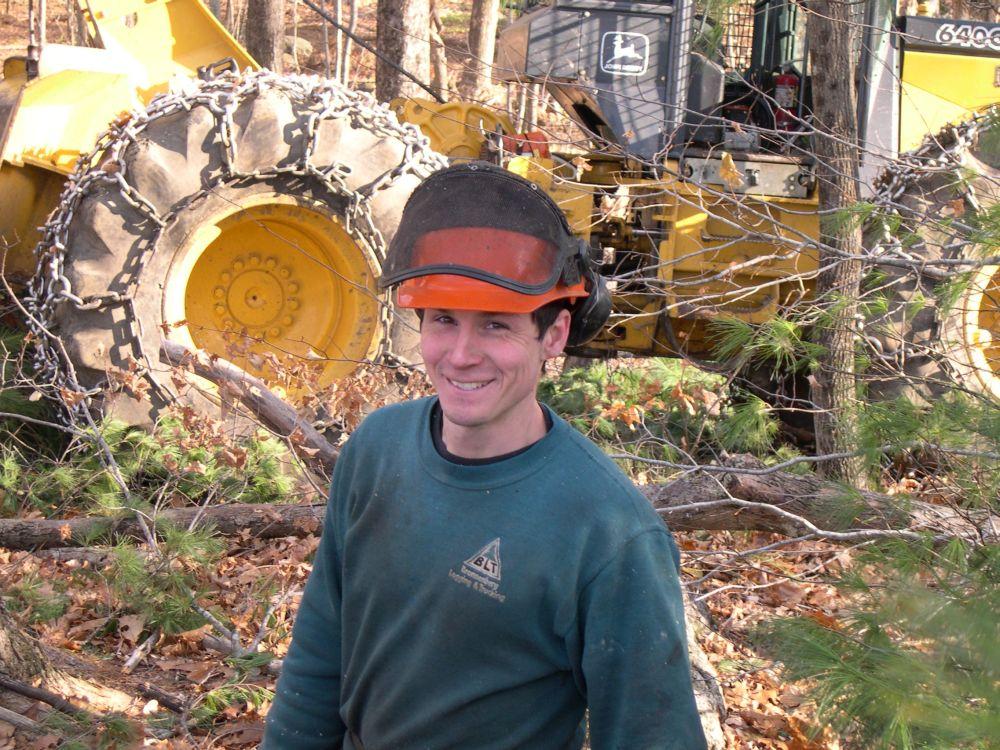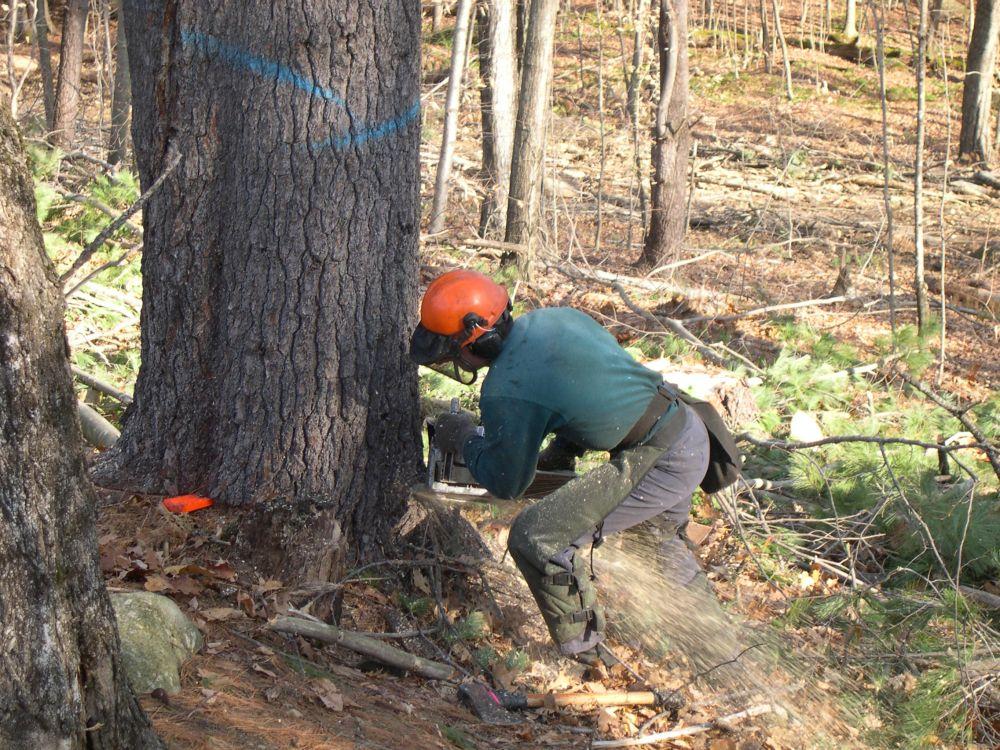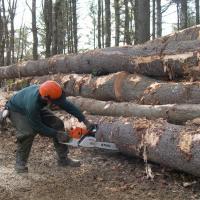Forest Journal
- Tags:
- Timber Harvesting,
- Working Forests

Logger, Jake Bronnenberg pauses while working at the Doscher family’s Windcrest Tree Farm in Weare.
Photos by Dave Anderson.
A Logging Life – Planning, Purpose and Pride
The smell of diesel fumes, fresh-cut pine and chainsaw exhaust mingle on a frosty, late-autumn morning. A cold snap froze the skid trails where logger, Jake Bronnenberg is wrapping-up logging job on the Doscher family’s Windcrest Tree Farm in Weare.
Bronnenberg knows the logging side of the forestry business very well. He’s old enough to have experienced market fluctuations and still young enough for the physical demands of woods work. Watching him work, it’s apparent that timber harvesting mandates a methodical approach, strategic thinking and efficiency of movement in the woods and at the log landing. From the first light of day, Bronnenberg has been thinking about the trees pre-marked for harvest; his game plan for the day.
The timber harvest will yield 110 thousand board feet (MBF) of timber, roughly 18 truckloads. The majority – 90 MBF is white pine and the balance of 20 MBF is red oak, maple, beech and ash. The pine and best hardwoods will become lumber. Poor quality and crooked hardwoods will be sold as roundwood for home heating. Bronnenberg is wrapping up the job, hand-felling a few remaining pines with a chainsaw.

Bronnenberg backs his yellow John Deere cable skidder up a slope below an ancient stonewall at the edge of an open field. He approaches a 90’ tall white pine and deftly cuts a steep, shallow notch facing the direction the tree will fall. He then pivots his chainsaw bar into the side of the stem and plunges through the heartwood to create a 2” strip of wood that will function as a hinge across the stump. He leaves a trigger of holding wood on the opposite side – opposite his notch for the final back-cut. He pounds a bright orange plastic wedge into the open saw-kerf slot, checks his intended escape and makes the final back cut and steps briskly away as the pine teeters slowly and falls with soft “whoosh” into a slot between surrounding trees. It falls exactly where he wants it.
Bronnenberg says “it’s important to realize you need a good plan for each tree: how you’re going to cut it and where you want to put it so you can get it out and how you’re going to buck it on the landing. You need to take care not to damage trees you want to grow for the next harvest.” He then limbs his way up the stem, removing branches. He cinches a choker chain around the butt of the log and winds the winch cable drawing logs to the rear of his skidder. The log rolls ninety degrees to reveal a few remaining branch stubs that he removes. He builds a hitch of two 45’ pine logs and then skids them to the log landing a few hundred yards away.
The process reveals practiced precision and efficiency. Even as he pulls logs to the landing, he calculates how he will buck the logs into smaller merchantable lengths to maximize the highest value in long lengths.
Landowner, Paul Doscher shows-off his woodlot. “Marlow soil is prime agricultural soil.” Well-drained and nutrient-rich, the open hilltop is where he grows commercial Christmas Trees. The woodlot downhill is trending to hardwoods, particularly oaks and sugar maples. “This was all pasture last farmed in the 1930’s.” Doscher explains how a prior timber harvest set the stage for the current harvest. “In 1987, we cut 40,000 feet of pine in a partial harvest. Twenty seven years later, we’re cutting the remaining pines.”
The timber harvest exemplifies how good forestry is done. The timing makes sense: wood markets are good and there it’s been a good seed year for red oak acorns and pine seed in southern NH. Released from the shade of the pines after this harvest, residual “pole-size” hardwoods stems will become the next forest. Doscher strolls through the now-open understory of black birch, oak and sugar maple. He points to the rapid growth visible wide outer growth rings in the stump of a fresh-cut oak. The 1987 timber harvest created ideal conditions for that oak to double in wood volume and value.

Back on the landing, Bronnenberg adds logs to a neatly stacked pile of pine. He pulls a log measuring tape along the pine and then demonstrates how he maximizes wood volume of the best log sections by cutting lengths of 10’, 12’ or 16’. He’s already thinking about how he’ll load these logs onto the truck for the road trip the mill. Before returning to the woods with the skidder, he looks around and offers “it takes 80-100 years to grow a high quality 24” red oak log. It’s important to maximize the value accumulated in each log for the landowner and for wood markets available.”
Potential critics tend to see all logging in a negative light. Timber harvesting creates sudden change, noise and the visual chaos of log piles, cut stumps, and the slash of limbs and stems left behind. A closer look reveals something more akin to gardening. Careful thinning of stems over decades requires temporary, short-term disturbance of periodic timber harvesting.
Bronnenberg emphasizes the long view: “Twenty seven years ago, the timber harvest created this crop of pine. A forester thinks ahead – kind of like a chess match – you need to plan the next move to create the right conditions for the next timber harvest to occur.”
